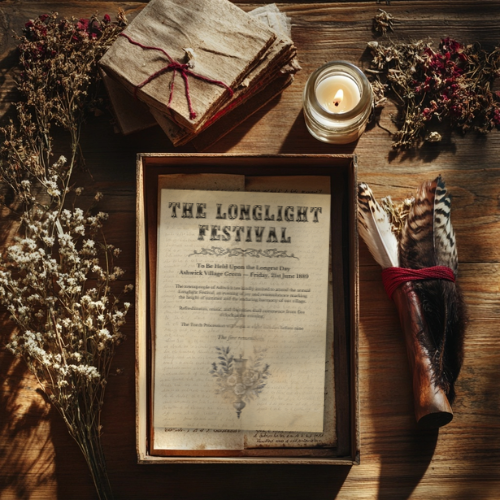Notes from the Inkpot
Writing, teaching, creating - one ink-stained idea at a time.

One Month In: What I’ve Learned from Launching My Own Website
One month after launching my website, I’m sharing what really happened. From the unexpected slow start to the small wins that made it all feel worth it. Here’s what I’ve learned, what surprised me, and why I’m more excited than ever for what’s coming next.

What Writing Taught Me About My Own Emotions (And How It Can Help Students Too)
Writing has always helped me untangle what’s going on in my own head, and it can do the same for students. In this post, I’m sharing how I teach personal narrative early in the year, why it’s linked to SEL, and how writing has helped me understand myself better.

7 Surprisingly Creative Ways English Teachers Can Use AI (That Don’t Involve Marking Essays)
Most AI-in-education advice focuses on grading and admin. But in the English classroom, that’s not always the issue that needs to be solved. This post shares 7 genuinely creative ways to use AI that support writing, analysis, differentiation, and reading, all designed to save time without losing your voice as a teacher.

What I Tell My Students During Exam Season (When They're Anxious, Fed Up, or Just Done)
It’s exam season, and students are feeling everything - nerves, bravado, burnout. In this post, I’m sharing what I tell mine before and after the paper, including the one phrase I never say, and the exam story I retell every year. If you’re teaching through GCSEs right now, this one’s for you.

How to Teach English Language Skills Using Literature Texts (Free Prompts Included)
Combine language and literature in a meaningful way with chapter-by-chapter creative writing prompts. This post explores how you can build writing skills while deepening students’ understanding of the texts you teach - plus, you’ll find lots of free resources to download and try right away.

10 Creative Writing Challenges to Stretch Your Imagination
Looking for ways to spark fresh ideas? These 10 creative writing challenges are perfect for classrooms, workshops, or solo writing sessions. From genre mashups to story reversals, each quick challenge helps stretch imagination, build skills, and unlock unexpected stories.

Teaching 1984: Activities, Experiments, and Real-World Connections
Teaching 1984 isn’t just about exploring a dystopian novel, it’s about showing students how power, control, and surveillance shape the world around them. In this post, I’m sharing how a real-world classroom experiment helped my students experience Orwell’s warnings firsthand, plus practical strategies for breaking down the novel’s complex themes in an engaging, accessible way.

10 Books Every Teacher Should Read to Protect Mental Health and Prevent Burnout
Teaching is one of the most meaningful careers, but it can take a serious toll on mental health. In this post, I’m sharing 10 powerful books that every teacher should read to build resilience, protect their wellbeing, and reignite their passion for the classroom.

Download a Free Daily Writing Prompt for Your Students (Plus 31 Bonus Prompts Inside)
Download a free daily writing prompt to spark creativity in your classroom - plus get 31 bonus prompts when you join the waitlist for my upcoming Daily Writing Prompt Membership. Low-prep, high-impact ideas to keep students engaged and excited to write!

Why Ray Bradbury Is the Original Black Mirror (and How to Teach Both in the Classroom)
Ray Bradbury might not have predicted Instagram likes or parental control implants, but his stories hold up like eerie reflections of our own tech-obsessed world. In this post, I pair classic Bradbury short stories with Black Mirror episodes to explore how both challenge our ideas about progress, power, and humanity. Perfect for teachers looking to spark meaningful discussions in the classroom.

Adolescence on Netflix: What It Reveals About Our Boys and Why Teachers Should Watch It
A gripping, real-time series, Adolescence doesn’t just tell a story, it forces us to confront one. Following the radicalisation of a 13-year-old boy who murders his classmate after she calls him an incel, this four-part drama explores how misogyny, isolation, and online influence can collide in devastating ways. In this post, I reflect on what the show gets right, how it mirrors the challenges in our schools, and why teachers should be paying close attention.

Famous First Lines as Writing Prompts: How to Spark Creativity Without Reinventing the Wheel
First lines are where everything begins -and for writers, they’re often the hardest part. That pressure to hook the reader immediately can be overwhelming. That’s exactly why I started collecting real first lines from published novels.
I use these with students to take the pressure off. Instead of staring at a blank screen, they start with something brilliant and build from there. It gives them structure and freedom all at once. It’s a reminder that writing isn’t about perfection. It’s about momentum.
Some lines are eerie. Some are emotional. Some are bold, jarring, or just weird enough to make you lean in. But the best ones all do the same thing: they open a door.
And that’s what these prompts are about. Opening the door, so the story can step through.

The Shoe Lesson: A Simple, Powerful Creative Writing Activity
What if one ordinary object could unlock a thousand extraordinary stories? The Shoe Lesson is one of my favourite creative writing activities - a simple, unexpected way to spark imagination, build character depth, and turn even the most reluctant writers into storytellers. Here's how a single shoe can transform your classroom or writing group.

Why Creative Writing Boxes Aren’t Just for Kids (And Why You Might Need One Too)
Creative writing boxes aren’t just for kids—and the ones I’ve built were never meant to be. They’re for adults and older teens who want to reconnect with writing, rediscover their creativity, or get lost in a story built from fragments, mystery, and atmosphere. If you've ever needed a spark to write again, this might be it.

How to Use Picture Prompts to Inspire Powerful Creative Writing
If you’ve ever felt like “describe the picture” prompts were falling flat, this is for you. In this post, I break down how I use picture prompts in the classroom to move beyond surface-level writing, and into rich, imaginative storytelling that students actually want to create.

Velvet Shadows and Candlelight: Why Darkness Belongs in the Classroom
Why are teens drawn to dystopias, gothic settings, and grief-soaked poetry? The answer might be simpler than you think. In this post, we explore how darker stories offer emotional depth, powerful writing opportunities, and space for healing inside the classroom.

The Kindling Collection: A Writing Box of Ritual, Firelight, and Uneasy Traditions
If you’ve ever wanted to stumble across a forgotten box of secrets, piece together a decades-old mystery, or uncover what a village has tried to forget, this is the one.
The Kindling Collection invites you into the village of Ashwick, where the Longlight Festival burns brighter than reason. What starts with weathered letters and faded photos slowly begins to feel… real. You’ll find cinnamon-scented fragments, unsettling children’s drawings, volunteer lists, and sealed envelopes that beg not to be opened.
Step into something old, strange, and quietly horrifying, and let the story pull you under.

10 Big Themes to Teach in Literature (That Students Actually Care About)
Tired of trying to make students care about literature? Start with themes that actually mean something to them. These ten big ideas - from identity and injustice to grief and resilience - are the ones students really connect with. Plus, I’ve included text suggestions and creative ways to teach each one.

Inside the Victoriana Collection: A Writing Box of Mystery, History, and Creative Intrigue
The Victoriana Collection isn’t a set of writing prompts. It’s a mystery told through forgotten photographs, torn letters, and eerie clues from another time. If you’re the kind of writer who finds inspiration in texture, mood, and fragments, this box was made for you. Gothic, atmospheric, and open-ended - this is where your next story begins.

Imposter Syndrome Is Lying to You: How to Own Your Voice in Teaching and Creativity
We don’t talk about it often, but imposter syndrome is everywhere in teaching - even among the most experienced educators. It doesn’t mean you’re failing. It means you care. And that’s a powerful place to start. In this post, I’m sharing my own experience with doubt, growth, and why your voice matters more than you think.